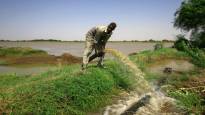Water-related conflicts are increasing around the world.
Although the world is full of bodies of water, only a fraction of it is suitable for human drinking.
Aalto University (you switch to another service) according to no less than 40 percent of the world’s population suffers from water scarcity. As an example: worldwide, more than 1,000 children under the age of five die every day from diseases linked to a lack of water, such as diarrhea, according to the UN children’s organization Unicef.
The availability of water has been made even more difficult by climate change, which has been reflected in disturbances in the water cycle, such as droughts and floods.
– We only have a limited amount of water in the world, which is not increasing, the Foreign Ministry’s special representative for water affairs tells STT Antti Rautavaara.
Despite the importance of water, many feel that it has not been valued high enough in decision-making. That’s why the UN water conference is starting today in New York, which is supposed to raise water to the core of high politics.
Need for water diplomacy
Due to the scarcity of water, it is also currently part of security and foreign policy.
– Water is a background factor in international disputes. When the scarcity of water increases, such disputes increase, says Rautavaara.
One of the most famous is the dispute between Ethiopia, Sudan and Egypt over the waters of the Nile. The Nile is a lifeline for all three states. Ethiopia is building a dam on the Nile, which Egypt and Sudan fear will threaten their water resources.
According to Rautavaara, there is a need for water diplomacy – and it does not only mean ongoing conflicts, but possible future conflicts.
Such risk areas for water conflicts are located, for example, in Central Asia and the Caucasus.
The consumption choices of Finns also affect water poverty
In Finland too, we cannot afford to think that water issues will be fine forever, says Rautavaara. Finns’ consumption choices affect the world’s water poverty.
– We have to remember that more than 50 percent of each of our water uses takes place outside the borders, says Rautavaara.
Finns’ water footprint is therefore largely in the world. For example, coffee, oranges and avocados are produced in areas that are very water-scarce.
Water is consumed not only in food production but also in the production of everyday consumer goods such as electronics.
Therefore, companies should also consider how to implement water responsibility in their own production chains.
